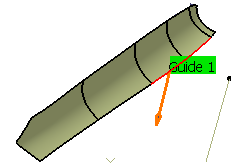Specify Guiding Contours
You can specify guiding contours in several ways.
-
Either
- Select
Contour detection in the bottom contextual menu
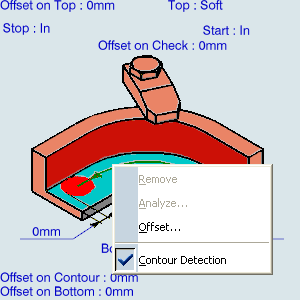
and select
the bottom element. The boundary of the selected face is proposed
as guiding contour.
- or select edges. In this case the
Selecting Edges and Faces to Define Geometry appears to help you specify the guiding contour.
- or select By Belt of Faces or By Boundary of Faces
in the guiding element contextual menu.
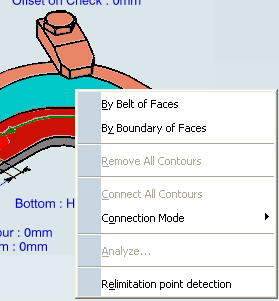
In this case the
Selecting Edges and Faces to Define Geometry appears to help you specify the guiding contour.

Specify Relimiting Elements
You can restrict the guiding contour with Start and Stop relimiting
elements.
Optional: Select the Normal View icon
in the View toolbar and a suitable face. The screen view is then perpendicular
to the selected face and makes it easier to define relimiting point locations
on the guide when moving the cursor.
Once a guiding contour has been defined, right-click the relimiting element in the sensitive icon and select
Add relimiting point.
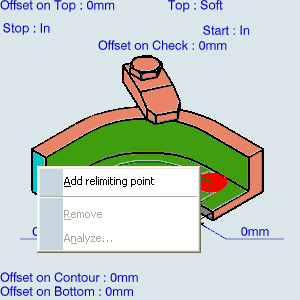
Note:
More than one relimiting elements are not supported and if you select one relimiting element after another then a warning message appears.

If associativity with the part is requested: - Create the points in the same product as the part,
- Select the points.
If associativity with the part is not requested:
- Select points on the fly anywhere on the guiding contour.
- or select Relimitation point detection in the contextual menu.

Select a guiding
contour, its extremities are used as relimiting elements.
Position the tool with regard to the Stop and Start relimiting elements.

When relimiting elements are defined on a closed contour, select the Close tool path option in order to respect the
area to machine according to the Direction of cut (Climb Milling
or Conventional) and the relimiting elements.

Machine Discontinuous Guiding Curves
You can machine several discontinuous groups of guiding elements in all
Profile Contouring modes (except By Flank Contouring).
Select the contours as explained above.
A Guide.x element is displayed for
each selected continuous ordered contour.
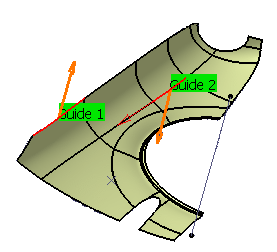
- The side to mill is shown by the orange arrow.
- The order of in which the geometric elements are selected
determines the order in which they can be machined.
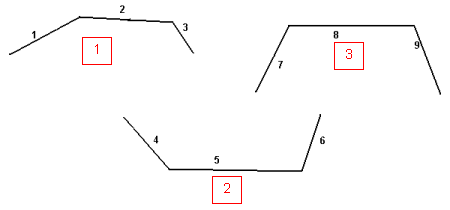
Optional:
Click the arrow to
inverse the side to mill.
Insert a linking macro to link two discontinuous portions of the
same tool path. Otherwise, a straight line is generated. Once the selection of the guides is validated (that is, when the dialog
box is displayed again), use the contextual menu that appears either on a guide in the authoring window or on a guide in the sensitive icon
of the dialog box
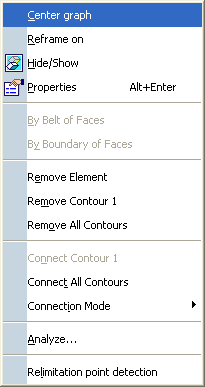
- Select Remove Element or launch the Edge Selection toolbar and pick an element again.
If the guide is no longer continuous, another
guide is created.
- Before:
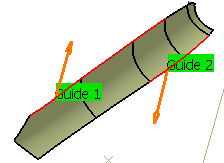
- After:
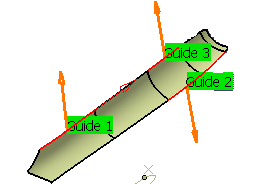
- Select Remove Contour x
The selected contour is removed:.
- Select Remove All Contours
All contours are removed:.
- Before:

- After:
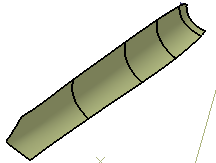
- Select a contour, then Connect Contour X and the target contour
The first contour is connected to the target one.
- Before:

- After:
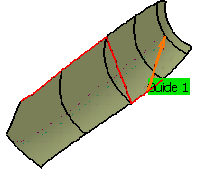
- Select Connect All Contours
All contours are connected together.
- Before:

- After:

- Select Connection mode to connect contours either by inserting
a line (Insert Line)or extrapolating a contour (Extrapolate
Contour).
|










